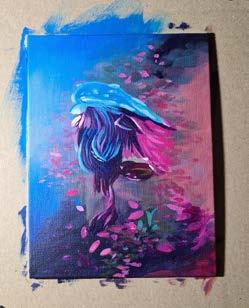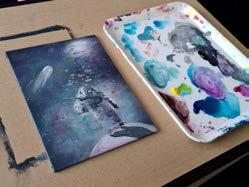
11 minute read
At the Intersection of Art and AI
Artwork by Noël C. Baker
A Conversation with Noël Baker
Advertisement
How are you incorporating generative AI into your artwork? How did you first start thinking about AI in relation to art?
I see generative AI as a tool, rather than the artist, just like any tool that’s come about in the art world or to humanity in general. It’s not like I’m using what AI generates, and that’s the art and that’s done. What I do is I use it as a tool to help me imagine, to give me different possibilities and take inspiration from. I use it to make a painting of my own creation; at no point is it a direct copy of something else. So it’s almost a collaboration more than it is a generation of art, because the end product is inspired by what I ask the AI to produce.
I’ve done a few art exhibitions, and I’m working on one big expo that’s coming up from April to June in Brussels, called “Seas & Oceans” (pictured above). And one of my main involvements with generative AI is the huge art piece I’m doing for this expo.
As a climate scientist, I wanted to talk about my relationship with environmental grief, and the experiences that I’ve had as a scientist being exposed to the changing environments, and the impact that humanity has on the degradation of the natural world. Through art, I imagine a world after climate change has occurred, after humanity has done the worst that we can do, to the point that humanity has killed itself off and most of the species on the planet. And all that’s left in the seas and oceans are species that could survive the impacts of climate change on the oceans which are warmer waters, higher dissolved carbon, basically a more acidic, warmer environment. I was trying to imagine what this would look like. A world after all of the species that we know and are familiar with have died off, and new species have evolved from the resilient ones that were able to survive climate change. So I wanted creatures that don’t currently exist, that have never existed on the planet.
So, I asked AI to generate creatures for me. The generative AI creates its own interpretation, where things are changed and warped. They are a little bit off and different, but still realistic enough that you can imagine them being real creatures. It ended up being the perfect collaboration, and I used these bizarre AI output creatures to populate my underwater world.
I must have spent 30-40 hours playing with the AI generator to get all these different creatures. And I went through hundreds and hundreds of different AI generated images to find the ones that I liked. And then I combined, and mixed, and just created this whole imagined new world.
A lot of it was just wanting to play and have fun, which is one of the joys of art; I see it as an opportunity to try and expand our horizons. Isn’t that really what art is about?
How do you see the role of generative AI in the art community?
AI used to be a tool that artists didn’t pay much attention to. But now it’s becoming so big that it has begun to threaten certain art communities. As an example, a friend of mine is a purely digital artist who doesn’t do any traditional painting on canvas; everything is done with a computer on a graphic design program. She feels deeply threatened by AI because everything she does can be reproduced to some reasonable-quality amount by AI.
This is a very serious threat for digital artists because their art can be used as training sets for the AI, and an artist’s style can be reproduced with exceptionally good fidelity to the point that you cannot distinguish what the AI produces from the artist’s original work.
I can understand why she feels threatened by the proliferation of generative AI. But my perspective is very different, and I think this is because I’m not a purely digital artist. Most of my art is paint on canvas. So, I don’t feel the same existential threat from AI. But I also feel like my approach and my perspective towards AI is more of the way a scientist might approach it. I’m not worried about AI because I use it purely as a tool.

Artwork by Noël C. Baker
Do you think there a way to misuse generative AI as a tool in the artworld?
Well, it’s an interesting question from the overall perspective of art. I like to look at it in the way we think of art history. So, consider a Renaissance artwork. It’s sometimes taken to be the ‘purest’ form of art. They look at a subject and create incredible lifelike portraits. But even they used a lot of tools and tricks. So even back during the golden age of the Renaissance, there is evidence that they used what technology they had at the time: optical instruments, mirrors, even projection technology to trace the images of what they were seeing directly onto the canvas.
Of course, they have wonderful skills to make the portrait realistic, but they’re skipping a lot of the painful process of getting the proportions.
So, what is pure art that’s untouched by technology?
At every step of the way along the path of art all the way up to now, with any tool that has been introduced, some people are going to say, oh, this is going to ruin art, this is going to ruin the whole industry, it’s going to ruin what makes an artist pure. There are always going to be people who are afraid of it or who say that this is the end and we’re never going to have purity like we once did. And while I understand there are serious problems with AI and art, I think it’s largely confined to the digital artist’s perspective.
In my opinion, generative AI is like any other technology: it can be used in the right way and in the wrong way, and the user should be given the knowledge and ability to make that decision to use it the best way they can.

Artwork by Noël C. Baker
What kind of opportunities do you see in using generative AI as a tool in your art? What are you excited about around having this onset of generative imagery for artists?
Accessibility is definitely the first one. Going back to my friends, the Renaissance artists. It used to be that if you wanted to become an artist, you would either have to be rich with a lot of free time on your hands, or you’d have to study for years. It was only something that was available to those few students who could study under those few masters.
Now that accessibility is open to anybody with an internet connection, which is just tremendous. I mean, the fact that anyone can pick up a pencil and paper is already a wonderful thing about art that it is accessible to anybody. But the ability to train and learn new things is becoming more and more open. I recently heard a story about someone who generated a children’s book entirely with AI images and generated text. He got a big backlash from the art and literature community because he made a whole children’s book which was purely generated, and he did it in a weekend.
But at the same time, he had a vision, he found the tools, and he produced something that’s of pretty good quality. I mean, that’s kind of cool from a scientist’s perspective. Like, how fun is it that you can now create something wonderful with a little bit of time and energy, and a lot of inspiration and passion. I find that wonderful and democratic.
Generative AI creates art in seconds, whereas a human artist will take hours or even months to create a single piece. Is there any inherent value, beyond the final artwork, that can be attributed to the time it takes for an artist to create the artwork?
On one hand, this guy produced a book within a weekend, which is incredibly fast. But artists were very quick to poke holes in the art that was generated. Hands, for example, are something that generative AI absolutely fails at. If you’ve ever tried to generate a handshake, it’s like there are 12 different fingers on each hand, or there are like three hands that are all grabbing different arms and elbows. And it’s just a monstrous mess.
It’s interesting because hands are also something that are traditionally very challenging even for pure traditional artists.
Even with producing art with generative AI, there’s a learning curve. To get an output that is actually decent requires quite a bit of time. It’s not a small task, and it’s not as straightforward as you might think. You can’t just push a button and have what you want to come out. It still takes work and effort.
I almost see that as a beautiful parallel between AI being in its infancy and artists learning from a young age how to do art, because hands are something that both fail at so spectacularly and take a lot of time to get right.
With AI as it is now, it’s a useful tool for some things, but it’s not nearly skilled enough to reproduce the Mona Lisa or any classical art piece that took many years of mastery, technique and perfection to reach.
So, time certainly still has value.
A couple months ago, I found someone on Instagram who had these beautiful watercolour paintings. They were so dreamy and strange; the details were like something straight out of a dream. Things are placed in ways you never would think. The people were all styled in this very strange, not modern style. I was just fascinated. So, I followed this person, and I was baffled because they were producing tons of artlike one or two pieces per day - and just getting lots of followers. And I couldn’t understand how they were making such amazing watercolor paintings so quickly. And then I looked a little bit further into their descriptions, and somewhere down there at the very bottom, it said AI generation; they had no other non-generated artwork. This was their art. It was all produced with AI.
So was it misleading? I don’t know. I was misled, but maybe I just wasn’t reading closely enough the first time.

Artwork by Noël C. Baker
When you realized those pieces were generated images, was your perspective or appreciation of the artwork altered? Do you think it matters how transparent artists are about their use of tools in creating art?
My first reaction was, oh, well, this isn’t nearly as good as I originally thought. I was very impressed by it considering what I thought in the beginning, which was that it’s a pure watercolor artwork. I was very impressed at their imagination and use of colors and details. It was just mind-blowing when I found out it was generated by AI; my first emotional reaction was disappointment.
And then my second one was that I wanted to try to recreate that! I wanted to figure out exactly which AI tool they used and exactly which inputs they used. I wanted to get exactly what they made, and through experimentation, I actually got pretty close, but not exact. So that was satisfying to me; it was almost like a game to try to figure out how they did it.
But does that mean it has less value? Again, instinctively, my first reaction is to say yes, because the amount of time it takes and the amount of work they put in to generate AI is a lot less than someone who was doing it traditionally. But does it have less value to the people who see it, and are inspired by it, and enjoy looking at beautiful watercolor paintings, and maybe buy one and put it on their wall? I’m not sure that it would.
What would you advise another artist curious about generative AI to do?
Play, have fun, explore, be creative, but make sure that what you produce is coming from you, make sure that it’s your creation in the end. That’s what I would tell an artist.

Follow Noël’s work on instagram: @noel.c.baker










